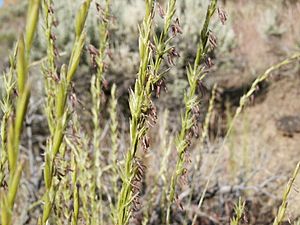Bluebunch wheatgrass facts for kids
Quick facts for kids Bluebunch wheatgrass |
|
|---|---|
 |
|
| Scientific classification | |
| Kingdom: | |
| (unranked): | |
| (unranked): | |
| (unranked): | |
| Order: | |
| Family: | |
| Genus: |
Pseudoroegneria
|
| Species: |
P. spicata
|
| Binomial name | |
| Pseudoroegneria spicata (Pursh) Á.Löve 1980
|
|
| Synonyms | |
|
List
Agropyron divergens (Steud.) P.Candargy
Agropyron divergens (Nees ex Steud.) Vasey Agropyron inerme (Scribn. & J.G.Sm.) Rydb. Agropyron spicatum (Pursh) Scribn. & J.G.Sm. Agropyron vaseyi Scribn. & J.G.Sm. Elymus spicatus (Pursh) Gould Elytrigia spicata (Pursh) D.R.Dewey Festuca spicata Pursh 1813 Roegneria spicata (Pursh) Beetle Schedonorus spicatus (Pursh) Roem. & Schult. Triticum aegilopoides Thurb. ex A.Gray 1863 not Forssk. 1775 Triticum divergens Steud. Zeia spicata (Pursh) Lunell |
|
Pseudoroegneria spicata is a type of grass commonly called bluebunch wheatgrass. This grass grows naturally in western North America. It is a perennial bunchgrass, meaning it lives for many years and grows in clumps. You can find it in the United States, Canada, and Mexico, from Alaska down to Sonora and Nuevo León.
Contents
What is Bluebunch Wheatgrass Like?
Bluebunch wheatgrass often looks different from other grasses. You can spot it by the small, hair-like parts called awns on its seedheads. These awns stick out almost straight from the stem. The grass itself often has a bluish color.
How it Handles Dry Weather
The roots of this grass have a special waxy layer. This layer helps the roots stay strong and resist drying out in dry soil. In places with more moisture, the grass might grow rhizomes. Rhizomes are underground stems that help the plant spread.
How it Changes with its Environment
This grass adapts to its surroundings. In warm, dry places, the plants are usually smaller. They also grow faster and have narrower leaves. Their leaves might be hairier, too. But in wetter areas with more nutrients, the plants tend to be bigger and taller. They also have larger leaves.
How its Roots Help it Grow
The roots of P. spicata are very good at surviving dry conditions. They can even compete with and stop the spread of unwanted plants called exotic weeds. The roots also react when they touch roots from other plants. For example, if plants from different places were grown together, they grew much bigger. This suggests that the roots can sense and avoid other plants from their own group.
The roots are also good at finding nutrients in the soil. They can take in more phosphorus when it's available. They also take in more nitrogen and potassium when the soil has extra nitrogen. This helps the whole plant get the food it needs to grow.
Where Does Bluebunch Wheatgrass Grow?
Pseudoroegneria spicata is a very common grass in the mountains of the western United States. It grows at many different heights, from 150 to 3,000 meters high. It likes areas that get about 250 to 500 millimeters of rain each year.
Its Favorite Places to Live
You can find this grass in many types of places. These include sagebrush areas, forests, woodlands, and grasslands. It grows well in sandy and clay soils. It can even grow on thin, rocky soils. However, it does not like soils that are too salty, too wet, or have too much alkalinity.
Different Kinds of Bluebunch Wheatgrass
There are two main types, or subspecies, of bluebunch wheatgrass. They are P. spicata ssp. spicata and P. spicata ssp. inerme. The second one is often called beardless bluebunch wheatgrass. The main difference is whether they have those hair-like awns or not. These two types can sometimes mix and create new plants.
Why is Bluebunch Wheatgrass Important?
This grass is a very important food source for both livestock (like cows and sheep) and wild animals in western North America. It is also widely used to help damaged land grow back. Special types of the grass have been created for this purpose.
State Grass
Bluebunch wheatgrass is so important that it is the official state grass for three states: Montana, Oregon, and Washington.
Challenges it Faces
Sometimes, other harmful plants called noxious weeds can grow faster than bluebunch wheatgrass. Examples include diffuse knapweed and medusahead. These weeds can take over the areas where bluebunch wheatgrass grows.
Images for kids
-
Pseudoroegneria spicata growing in Chelan County, Washington


